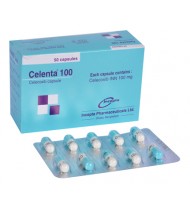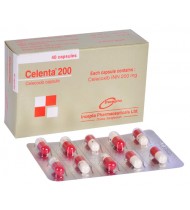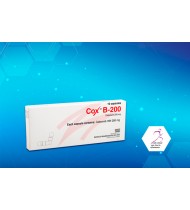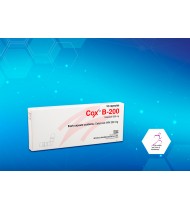Celecoxib
Indications
- For the relief of the signs and symptoms of osteoarthritis.
- For the relief of the signs and symptoms of rheumatoid arthritis.
- For the regression and prevention of colorectal adenomatous polyps in patients with familial adenomatous polyposis (FAP).
Pharmacology
Dosage & Administration
Rheumatoid arthritis: The recommended oral dose is 100 to 200 mg twice daily.
Familial adenomatous polyposis (FAP): Usual medical care for FAP patients should be continued while on Celecoxib. To reduce the number of adenomatous colorectal polyps in patients with FAP, the recommended oral dose is 400 mg (2x200 mg capsules) twice daily to be taken with food.
Interaction
Frusemide: NSAIDs can reduce the natriuretic effect of Frusemide and thiazides in some patients.
Aspirin: Celecoxib can be used with low dose Aspirin. However, concomitant administration of Aspirin with Celecoxib may result in an increased rate of gastrointestinal ulceration or similar complications, compared to the use of Celecoxib alone.
Fluconazole: Concomitant administration of Fluconazole at 200 mg qid resulted in a two fold increase in Celecoxib plasma concentration. Celecoxib should be introduced at the lowest recommended dose in patients receiving Fluconazole.
Lithium: Patients on Lithium treatment should be closely monitored when Celecoxib is introduced or withdrawn.
Warfarin: Caution should be used when administering Celecoxib with Warfarin since these patients are at increased risk of bleeding complications.
Co-administration of Celecoxib with aluminium and magnesium-containing antacid should be avoided, because they may reduce the amount of Celecoxib that the body absorbs.
Contraindications
Side Effects
- General: Allergy aggravated, allergic reaction, asthenia, chest pain, oedema generalised, face oedema, fatigue, fever, hot flushes, influenza like symptoms, pain, peripheral pain.
- Gastrointestinal: Constipation, diverticulitis, dysphagia, oesophagitis, gastritis, gastroenteritis, gastro-oesophageal reflux disease, haemorrhoids, hiatal hernia, melaena, dry mouth, stomatitis, tenesmus, tooth disorder, vomiting.
- Cardiovascular: Aggravated hypertension, angina pectoris, coronary artery disease, myocardial infarction.
- Nervous system: Leg cramps, hypertonia, hypoesthesia, migraine, neuralgia, neuropathy, paresthesia, vertigo. Female reproductive system : Breast fibroadenosis, breast neoplasm, breast pain, dysmenorrhoea, menstrual disorder, menorrhagia, vaginitis.
- Male reproductive system: Prostatic disorder.
- Resistance mechanism disorders: Herpes simplex, herpes zoster, bacterial infection, fungal infection, infection of soft tissue, viral infection, moniliasis, moniliasis genital, otitis media.
- Hearing and vestibular: Deafness, ear abnormality, earache, tinnitus.
- Heart rate and rhythm: Palpitation, tachycardia.
- Respiratory: Bronchitis, bronchospasm, bronchospasm aggravated, coughing, dyspnoea, laryngitis, pneumonia.
- Liver and biliary system: Peptic function abnormal, increased AST and ALT.
- Musculoskeletal: Arthralgia, arthrosis, accidental fracture, myalgia, neck stiffness, synovitis, tendinitis.
- Urinary system: Albuminuria, cystitis, dysuria, haematuria, micturition frequency, renal calculus, urinary incontinence, urinary tract infection.
- Metabolic and nutritional: Blood urea nitrogen (BUN), CPK, creatinine, alkaline phosphatase, are increased. Hypercholesterolaemia, hyperglycaemia, hypokalaemia. Bodyweight is also increased.
- Psychiatric: Anorexia, anxiety, increased appetite, depression, nervousness, somnolence.
- Haemic: Anaemia, ecchymosis, epistaxis, thrombocythaemia.
- Skin and appendages: Alopecia, dermatitis, photosensitivity reaction, pruritus, rash erythematous, rash maculopapular, skin disorder, dry skin, increased sweating, urticaria.
- Application site disorders: Cellulitis, contact dermatitis, skin nodule.
- Special senses: Taste perversion.
- Vision: Blurred vision, cataract, conjunctivitis, eye pain, glaucoma.
Pregnancy & Lactation
Precautions & Warnings
Use in Special Populations
Paediatric: The safety and efficacy of Celecoxib is not established in pediatric patients.
Hepatic insufficiency: Celecoxib capsules should be introduced at a reduced dose in patients with moderate hepatic impairment. The use of Celecoxib in patients with severe hepatic impairment is not recommended.
Overdose Effects
Therapeutic Class
Storage Conditions
Celenta Capsule 100 mg
IndicationsCelecoxib is indicated-For the relief of the signs and symptoms of osteoarthritis.For the..
4.50Tk.
Celenta Capsule 200 mg
IndicationsCelecoxib is indicated-For the relief of the signs and symptoms of osteoarthritis.For the..
8.00Tk.
Cox B Capsule 100mg
IndicationsCelecoxib is indicated-For the relief of the signs and symptoms of osteoarthritis.For the..
4.50Tk.
Cox B Capsule 200 mg
IndicationsCelecoxib is indicated-For the relief of the signs and symptoms of osteoarthritis.For the..
8.00Tk.
Ezy Capsule 100 mg
IndicationsCelecoxib is indicated-For the relief of the signs and symptoms of osteoarthritis.For the..
4.50Tk.
Ezy Capsule 200 mg
IndicationsCelecoxib is indicated-For the relief of the signs and symptoms of osteoarthritis.For the..
8.00Tk.





